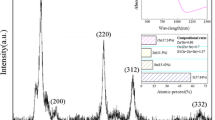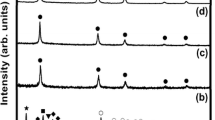Abstract
The present study demonstrates a mechanochemical “micro-nano” approach toward the future solar cell absorber material Cu2ZnSnS4 (CZTS) with up-scaling potential. For this purpose, synthetic copper sulfide CuS and tin sulfide SnS nanoparticles along with microsized zinc metal and elemental sulfur as solid precursors were utilized. These precursors were milled in a planetary ball mill in an argon atmosphere for a period of 1–240 min. Moreover, we compare it to a “micro” approach starting from the elements and maintaining the same milling conditions. The phase composition of reaction mixtures was analyzed by X-ray diffractometry. The final products of syntheses were further analyzed by means of scanning and transmission electron microscopy, X-ray photoelectron spectroscopy, and UV–Vis spectroscopy. The phase purity of the prepared materials was verified by confocal Raman microscopy. In both cases, a polydisperse system of a nearly stoichiometric Cu2ZnSnS4 phase was readily obtained after 60 min of milling with only traces of unreacted Cu2−xS phases. Based on the results, we conclude there is no definite difference in reaction speed. However, the crystallite size and optical properties of the prepared CZTS samples slightly differ when various precursors are used.













Similar content being viewed by others
References
Polman A (2016) Photovoltaic materials: present efficiencies and future challenges. Science 352:307–316. https://doi.org/10.1126/science.aad4424
Green MA, Emery K, Hishikawa Y et al (2017) Solar cell efficiency tables (version 49). Prog Photovoltaics Res Appl 25:3–13. https://doi.org/10.1002/pip.2855
Wang W, Winkler MT, Gunawan O et al (2014) Device characteristics of CZTSSe thin-film solar cells with 12.6% efficiency. Adv Energy Mater 4:1–5. https://doi.org/10.1002/aenm.201301465
Sun K, Yan C, Liu F et al (2016) Over 9% efficient kesterite Cu2ZnSnS4 solar cell fabricated by using Zn1−xCdxS Buffer Layer. Adv Energy Mater 6:1600046. https://doi.org/10.1002/aenm.201600046
Washio T, Shinji T, Tajima S et al (2012) 6% Efficiency Cu2ZnSnS4-based thin film solar cells using oxide precursors by open atmosphere type CVD. J Mater Chem 22:4021. https://doi.org/10.1039/c2jm16454j
Ma R, Yang F, Li S et al (2016) Fabrication of Cu2ZnSn(S, Se)4 (CZTSSe) absorber films based on solid-phase synthesis and blade coating processes. Appl Surf Sci 368:8–15. https://doi.org/10.1016/j.apsusc.2016.01.242
Bae SH, Zhao H, Hsieh YT et al (2016) Printable solar cells from advanced solution-processible materials. Chem 1:197–219
Das S, Mandal KC, Bhattacharya RN (2015) Earth-abundant Cu2ZnSn(S, Se)4 (CZTSSe) solar cells. Semicond Mater Solar Photovol Cells 218:25–74
Delbos S (2012) Kësterite thin films for photovoltaic: a review. EPJ Photovoltaics 3:35004. https://doi.org/10.1051/epjpv/2012008
Muska K, Kauk M, Altosaar M et al (2011) Synthesis of Cu2ZnSnS4 monograin powders with different compositions. Energy Proc 10:203–207
Shockley W, Queisser HJ (1961) Detailed balance limit of efficiency of p-n junction solar cells. J Appl Phys 32:510–519. https://doi.org/10.1063/1.1736034
Song X, Ji X, Li M et al (2014) A review on development prospect of CZTS based thin film solar cells. Int J Photoenergy 2014:1–11
Katagiri H, Jimbo K, Yamada S et al (2008) Enhanced conversion efficiencies of Cu2ZnSnS4-based thin film solar cells by using preferential etching technique. Appl Phys Express 1:0412011–0412012. https://doi.org/10.1143/APEX.1.041201
Moholkar AV, Shinde SS, Agawane GL et al (2012) Studies of compositional dependent CZTS thin film solar cells by pulsed laser deposition technique: an attempt to improve the efficiency. J Alloys Compd 544:145–151. https://doi.org/10.1016/j.jallcom.2012.07.108
Wang K, Gunawan O, Todorov T et al (2010) Thermally evaporated Cu2ZnSnS4 solar cells. Appl Phys Lett 97:143508. https://doi.org/10.1063/1.3499284
Sani R, Manivannan R, Victoria SN (2017) One step electrochemical deposition of CZTS for solar cell applications. Chalcogenide Lett 14:165–170
Todorov T, Mitzi DB (2010) Direct liquid coating of chalcopyrite light-absorbing layers for photovoltaic devices. Eur J Inorg Chem 2010:17–28
Wang Y, Gong H (2011) Cu2ZnSnS4 synthesized through a green and economic process. J Alloys Compd 509:9627–9630. https://doi.org/10.1016/j.jallcom.2011.07.041
Shyju TS, Anandhi S, Suriakarthick R et al (2015) Mechanosynthesis, deposition and characterization of CZTS and CZTSe materials for solar cell applications. J Solid State Chem 227:165–177. https://doi.org/10.1016/j.jssc.2015.03.033
Pareek D, Balasubramaniam KR, Sharma P (2015) Synthesis and characterization of bulk Cu2ZnSnX4 (X: S, Se) via thermodynamically supported mechano-chemical process. Mater Charact 103:42–49. https://doi.org/10.1016/j.matchar.2015.03.014
Park B-I, Hwang Y, Lee SY et al (2014) Solvent-free synthesis of Cu2ZnSnS4 nanocrystals: a facile, green, up-scalable route for low cost photovoltaic cells. Nanoscale 6:11703–11711. https://doi.org/10.1039/C4NR02564D
Pareek D, Balasubramaniam KR, Sharma P (2017) Reaction pathway for synthesis of Cu2ZnSn(S/Se)4 via mechano-chemical route and annealing studies. J Mater Sci Mater Electron 28:1199–1210. https://doi.org/10.1007/s10854-016-5646-3
Ritscher A, Schlosser M, Pfitzner A, Lerch M (2016) Study of the mechanochemical process to crystalline Cu2ZnSnS4 powder. Mater Res Bull 84:162–167. https://doi.org/10.1016/j.materresbull.2016.08.006
Quennet M, Ritscher A, Lerch M, Paulus B (2017) The order-disorder transition in Cu2ZnSnS4: a theoretical and experimental study. J Solid State Chem 250:140–144. https://doi.org/10.1016/j.jssc.2017.03.018
Zhou Z, Wang Y, Xu D, Zhang Y (2010) Fabrication of Cu2ZnSnS4 screen printed layers for solar cells. Sol Energy Mater Sol Cells 94:2042–2045. https://doi.org/10.1016/j.solmat.2010.06.010
Mokurala K, Bhargava P, Mallick S (2014) Single step synthesis of chalcogenide nanoparticles Cu2ZnSnS4, Cu2FeSnS4 by thermal decomposition of metal precursors. Mater Chem Phys 147:371–374. https://doi.org/10.1016/j.matchemphys.2014.06.049
Pani B, Pillai S, Singh UP (2016) Kesterite based thin film absorber layers from ball milled precursors. J Mater Sci Mater Electron 27:12412–12417. https://doi.org/10.1007/s10854-016-5205-y
Guan P-W, Shang S-L, Lindwall G et al (2017) Phase stability of the Cu-Sn-S system and optimal growth conditions for earth-abundant Cu2SnS3 solar materials. Sol Energy 155:745–757. https://doi.org/10.1016/j.solener.2017.07.017
Liu CQ, Wen B, Wang N et al (2017) Phase evolution and sintering behaviors of Cu2ZnSnS4 powders synthesized by mechanochemical process with different milling parameters. J Alloys Compd 708:428–436. https://doi.org/10.1016/j.jallcom.2017.03.008
Baryshev SV, Thimsen E (2015) Enthalpy of formation for Cu-Zn-Sn-S (CZTS) calculated from surface binding energies experimentally measured by ion sputtering. Chem Mater 27:2294–2298. https://doi.org/10.1021/cm504749d
Baláž M, Zorkovská A, Urakaev F et al (2016) Ultrafast mechanochemical synthesis of copper sulfides. RSC Adv 6:87836–87842. https://doi.org/10.1039/C6RA20588G
Rodriguez-Carvajal J (2003) FullProf suite. LLB Sacley LCSIM Rennes, Fr
(PDF) S (JCPDS) PDF (2004) Powder Diffraction File (PDF)
Hall SR, Szymanski JT, Stewart JM (1978) Kesterite, Cu2(Zn, Fe)SnS4 and stannite Cu2(Fe, Zn)SnS4, structurally similar but distinct minerals. Can Mineral 16:131–137
Valakh MY, Kolomys OF, Ponomaryov SS et al (2013) Raman scattering and disorder effect in Cu2ZnSnS4. Phys Status Solidi - Rapid Res Lett 7:258–261. https://doi.org/10.1002/pssr.201307073
Fontané X, Izquierdo-Roca V, Saucedo E et al (2012) Vibrational properties of stannite and kesterite type compounds: Raman scattering analysis of Cu2(Fe, Zn)SnS4. J Alloys Compd 539:190–194. https://doi.org/10.1016/j.jallcom.2012.06.042
Lund EA, Du H, Hlaing Oo WM et al (2014) Investigation of combinatorial coevaporated thin film Cu2ZnSnS4 (II): beneficial cation arrangement in Cu-rich growth. J Appl Phys 115:173503. https://doi.org/10.1063/1.4871665
Fontań X, Calvo-Barrio L, Izquierdo-Roca V et al (2011) In-depth resolved Raman scattering analysis for the identification of secondary phases: characterization of Cu2 ZnSnS4 layers for solar cell applications. Appl Phys Lett 98:2011–2014. https://doi.org/10.1063/1.3587614
Tao J, Liu J, Chen L et al (2016) 7.1% efficient co-electroplated Cu2ZnSnS4 thin film solar cells with sputtered CdS buffer layers. Green Chem 18:550–557. https://doi.org/10.1039/C5GC02057C
Baláž P, Baláž M, Zorkovská A et al (2017) Kinetics of solid-state synthesis of quaternary Cu2FeSnS4 (stannite) nanocrystals for solar energy applications. Acta Phys Pol A 131:1153–1155. https://doi.org/10.12693/APhysPolA.131.1153
Baláž P (2008) Mechanochemistry in Nanoscience and Minerals Engineering. Springer, Berlin
Li Y, Guo H, Wang X et al (2016) Suppression of charge recombination by application of Cu2ZnSnS4–graphene counter electrode to thin dye-sensitized solar cells. Sci Bull 61:1221–1230. https://doi.org/10.1007/s11434-016-1120-0
Chang ZX, Chong RF, Meng YN et al (2015) High temperature recrystallization of kersterite Cu2ZnSnS4 towards enhanced photocatalytic H2 evolution. Int J Hydrogen Energy 40:13456–13462. https://doi.org/10.1016/j.ijhydene.2015.08.032
Malerba C, Biccari F, Ricardo CLA et al (2014) CZTS stoichiometry effects on the band gap energy. J Alloys Compd 582:528–534. https://doi.org/10.1016/j.jallcom.2013.07.199
Shibuya T, Goto Y, Kamihara Y et al (2014) From kesterite to stannite photovoltaics: stability and band gaps of the Cu2(Zn, Fe)SnS4 alloy. Appl Phys Lett 104:021912. https://doi.org/10.1063/1.4862030
Viezbicke BD, Patel S, Davis BE, Birnie DP (2015) Evaluation of the Tauc method for optical absorption edge determination: ZnO thin films as a model system. Phys Status Solidi 252:1700–1710. https://doi.org/10.1002/pssb.201552007
Acknowledgements
This work was supported by projects of the Slovak research and development agency APVV (VV-0103-14) and the Slovak grant agency VEGA (2/0044/18, 2/0065/18). The support of the European project COST (OC-2015-1-19345) and the APVV (VV-15-0641), VEGA 2/0010/15 projects is also acknowledged. The work was done during implementation of the projects ITMS 26240220047 (50%) and ITMS 26240220028 (25%) supported by the Research and Development Operational Program funded by the ERDF.
Author information
Authors and Affiliations
Corresponding author
Rights and permissions
About this article
Cite this article
Hegedüs, M., Baláž, P., Baláž, M. et al. Mechanochemical approach to a Cu2ZnSnS4 solar cell absorber via a “micro-nano” route. J Mater Sci 53, 13617–13630 (2018). https://doi.org/10.1007/s10853-018-2228-1
Received:
Accepted:
Published:
Issue Date:
DOI: https://doi.org/10.1007/s10853-018-2228-1




